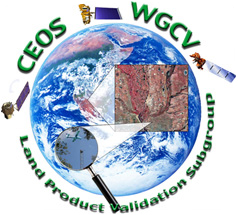
Focus Area on Land Cover Product Validation
Sophie Bontemps, Université catholique de Louvain, Belgium
Alexandra Tyukavina, University of Maryland, USA
Nandika Tsendbazar, Wageningen University, The Netherlands
Land Cover Definition
Land cover is defined as the observed (bio)-physical cover on the Earth's terrestrial surface. It includes vegetation and man-made features as well as bare rock, bare soil and inland water surfaces (Di Gregorio, 2005).
Units:
The primary units for characterizing land cover are categories (e.g. Forest or Open Water) or continuous variables classifiers (fraction of Tree Canopy Cover). Secondary outputs include surface area of land cover types (hectares), land cover change (area and change trajectories) (GTOS, 2009).
Highest Validation Stage Currently Reached for Satellite-Derived Land Cover Products
Validation stage 4 (LPV validation stage hierarchy) - While most products are not validated higher than stage 3, recent efforts demonstrated that the validation stage 4 was achievable. The Copernicus global 100 m land cover maps (2015-2019) and the CCI Land Cover times series (1992-2018) were both operationally validated across years. This has been possible through the interpretation of very-high resolution reference data sets from multiple sources that were regularly updated over successive years. Global daily coverage of very high-resolution imagery is currently provided by commercial satellite constellations (RapidEye, SkySat, PlanetScope), which, if given wide access to the scientific community, will enable operational validation of products for more recent years. Limited access to these high-resolution datasets is provided through Planet Educational and Research programs and NASA's Commercial Smallsat Data Acquisition program. However, no consistent global coverage of very high-resolution data is available for historic mapping efforts (pre-2010)
Validation Good Practices
Land cover validation:Strahler, A.H., Boschetti, L., Foody, G.M., Friedl, M.A., Hansen, M.C., Herold, M., Mayaux, P., Morisette, J.T., Stehman, S.V. and C.E. Woodcock 2006. Global Land Cover Validation: Recommendations for Evaluation and Accuracy Assessment of Global and Cover Maps. European Commission Joint Research Centre, Institute for Environment and Sustainability. Scientific and Technical Research Series: EUR 22156 EN. 48 pp.
Land cover change validation:Olofsson, P., Foody, G. M., Herold, M., Stehman, S. V., Woodcock, C. E. and Wulder, M. A. (2014). Good Practices for Assessing Accuracy and Estimating Area of Land Change. Remote Sensing of Environment. 148:42-57.
Method and Guidance Document (MGD) is produced by the Global Forest Observations Initiative (GFOI) with the aim to provide user-friendly guidance for linking UNFCCC decisions related to REDD+ Measurement, Reporting, and Verification (MRV) with IPCC guidance. It further includes guidance on product accuracy assessment and area estimation on change in forest cover.
Land Cover Validation Reference Data Sets
The WorldCereal Reference Data Module has been set up to assist in the generation of accurate crop type maps. The module provides access to the high quality reference data needed for the training and validation of such products.
WorldCereal Reference Data Module.
Best currently available reference data for satellite-derived medium-resolution land cover product validation are based on higher-quality reference data, such as independent validation datasets and regional maps. Tsendbazar et al., 2014 reviewed existing land cover reference data sets and their suitability as function of the user community. With increasing resolution of future land cover products, the existing reference data sets will need further development.
GOFC-GOLD Reference Data Portal.
LPV Focus Areas
Meetings
IGARSS 2021, Special Session, CEOS Land Product Validation: Sampling-based estimation of area and accuracy for Land Cover products, Jul 11 -16, 2021, Brussels, Belgium
- NASA Official: Sadashiva Devadiga
- Website Manager: Jaime Nickeson
- Last Updated: July 17, 2025


